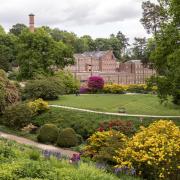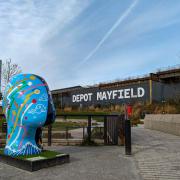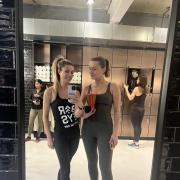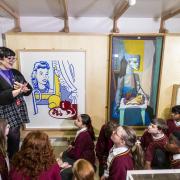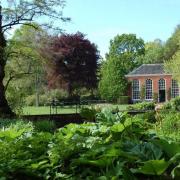Ceramicist Matt Sherratt works from a tiny studio in a corner of the Cholmondeley Castle estate, near Malpas, writes Kate Houghton

I’m on my way to meet a local artist with a growing reputation. It’s a lovely drive through some of Cheshire’s most beautiful countryside and my arrival at Matt’s studio, housed in one of the old outhouses next to the Cholmondeley Castle Estate office, is a first excellent step in getting to know this artist, as it seems just as an artist’s studio should be.
The space is filled with a large table, a small potter’s wheel (next to which sit a selection of various sized discs on which Matt throws his clay to start the process), some slightly rickety looking shelving and lots of mysterious tools. Oh, and a collection of fascinating and beautiful ceramics, in colours from winter white to rose gold, Jamaican scarlet to emerald green.
Matt is welcoming, keen to show us what he does yet unsure of his ability to explain it. Art doesn’t need explanation though, its joy lies in its ability to engage, and engage it does. Both Kirsty (our photographer) and I are immediately drawn to Matt’s creations and demand that he shows us each stage of how he forms them, which he does with great patience.
Matt graduated with a first class degree in ceramics from Loughborough University, and, having completed a thesis in art therapy, worked in mental health for a while before taking himself off on a cycle ride across India and Nepal, SE Asia, Australia and New Zealand. On his return to the UK, he did the ‘sensible thing’ and completed a teacher training programme, resulting in a role at the City Literary Institute, now based in Covent Garden.

‘It’s a fantastic college,’ Matt tells me. ‘A real hub of activity for adult education. I still go back and teach at the summer schools.’
It would have been easy for Matt to continue his life in this way, but luckily a career move took his wife Antoinette back to her roots in Wales.
‘I set up a new studio in North Wales, near Betws y Coed, and this was my first step into becoming a full-time sculptor,’ he says.
‘It was quite tough. I had adjusted to teaching and running workshops in London, where I had been for 12 years, including two years at the Royal College of Art, and I was completely starting again. It takes some while to develop any level of competency in what you want to do, and then you have to get your name known.’

The basic form of Matt’s work is a circle of clay, smoothed and twisted into a positively dynamic endless loop, painted with a grand variety of colours. I wonder where this concept developed from.
‘That’s a very difficult question to answer,’ he says, slowly. ‘I’ve seen so much and been inspired by so much, but it has always been a journey through curved forms, whether a body arched in yoga, sails on a boat or the curve of a hillside. It’s taken years and years to get this far and it’s always evolving.
‘The most recent change has been the move from quite austere whites and golds to using primary colours. It was all very stripped down, working with the basic forms. As I worked I nagged myself: “you really need to do something different!” and eventually something clicked and I went out and bought a load of colours.’
Matt and his wife moved to Cheshire to follow her work, taking a cottage on the Cholmondeley Estate. When the family discovered what he did, they suggested he set up his studio in one of their empty outhouses.

‘They’re a very creative family and have a great interest in the arts so it seems to make sense,’ he suggests.
Having spotted the potter’s wheel, I want to see it in action, and ask for a demo – not actually expecting to get one…
‘I spent two years at the Royal College of Art,’ he says, as he takes a huge lump of clay and throws it down onto the wheel. ‘I studied making slipcast ware there but got fed up, as using moulds felt like a lack of creativity. I was doing clay throwing as part of my teaching and just got more and more drawn to that.’
As he talks, his wheel spins and he deftly creates a curved hillock from his clay, easing it lower and wider till it fills the disk. Within minutes it’s a donut, with a central hole and curving sides. I am amazed at how physical the process is, with Matt seemingly leaning his whole bodyweight into the action.
‘There are so many ways to work on a potter’s wheel – it offers both constraint and freedom in one movement. I can vary the size of the wheel and my biggest one is 60cm, which can hold 12.5kg of clay. I’d like to go bigger, but I’m currently restricted by the size of my kiln.
‘I use a white clay from Stoke,’ he tells me. ‘Sculpturally it’s the strongest you can get and also takes the colours so well.’
He lifts the clay from the wheel and wraps it up, then shows us a piece he’s got in progress, where he uses various tools to define the curves he’s created, cutting and smoothing until his artist’s eye and heart tell him it’s ready.
‘The quality of finish must be absolute. There’s no short cut to getting a great piece, you just have to keep going till you realise that balance of real creativity and a sense of its absolute completion. There’s a balance of course between expressing yourself and making something accessible.
‘The real test of course comes when someone parts with cold hard cash for your work; that’s the moment you know that someone truly appreciates what you do.’
Matt is currently preparing for two upcoming exhibitions, one early next year at Mayfair’s Gallery 54 and another at Chester Cathedral in May, following their current, extraordinary, Ark exhibition.
‘The art is absolutely stunning,’ Matt says, slightly wide eyed. ‘Top class sculptors from all over the world – and then I’m in next.’
Judging from the awestruck reaction from passers by when he took some pieces to the cathedral to plan the layout – and from my own and our photographer’s response to his pieces in the studio – he need have no concerns.






